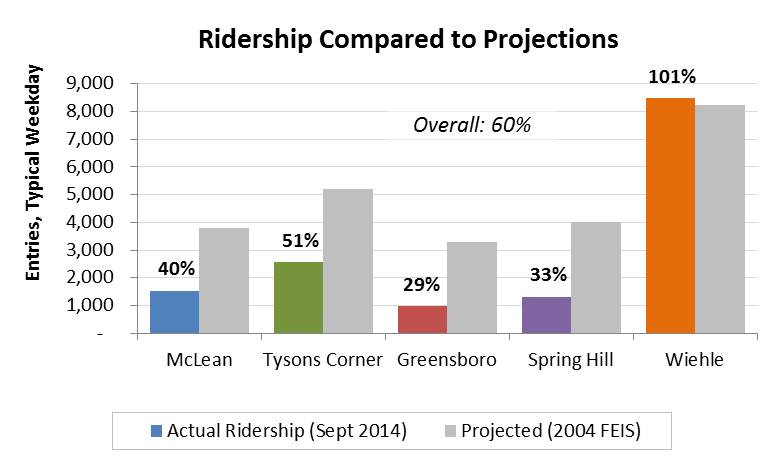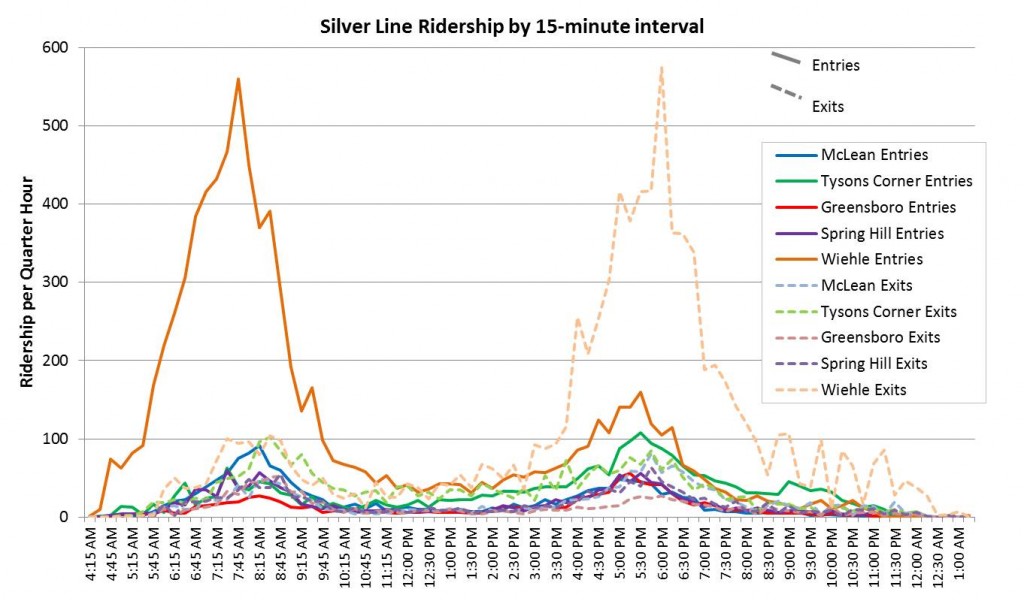Early Ridership on the Silver Line
After just two months, ridership on the Silver Line is off to a solid start: Wiehle Ave is already over projections, reverse commuting is strong, and more.
Now that school is back in session and most summer vacations over, here is an in-depth look at the week of September 8-12, 2014, when “normal” routines may have begun to emerge.
At around 15,000 entries per weekday, the Silver Line is off to a solid start. Compared to the official projections from the 2004 Final Environmental Impact Statement (FEIS), we are achieving about 60% of the ridership projected for the end of the line’s first year:
 Wiehle station is already over opening-year projections and shows the highest ridership of all the new stations. Tysons Corner station is strong as well, but we still have room to grow at all four stations located in the Tysons area.
Wiehle station is already over opening-year projections and shows the highest ridership of all the new stations. Tysons Corner station is strong as well, but we still have room to grow at all four stations located in the Tysons area.
Looking at ridership by time of day shows the Wiehle is a commuting powerhouse, but also that a strong reverse commute market is emerging at the other stations:
- McLean (in blue) is showing an early lead as a a “traditional” commute station, where most riders enter in the morning.
- Tysons Corner is much more dominated by reverse commuters, and its morning rush extends into mid-morning (around 10:00am). Evening ridership at Tysons Corners is also heavy. (More on off-peak ridership at Tysons coming soon)
- Greensboro and Spring Hill show relatively light ridership so far, but ridership is expected to grow over time as development catches up with the new station.
What do you think? Have you taken the Silver Line on a weekday? What was your experience?
The raw data by quarter-hour interval underlying this analysis is available in two formats: by station alone (2MB, .xlsx), and by origin-destination station (3MB, zipped tab-delimited .txt).



I’d like to see a post on the Silver Line’s impact on existing public transportation in the area – particularly on the Orange Line and ridership at Vienna. An earlier write up suggested most Wiehle riders are existing riders who have switched their point of entry, presumably from Vienna. But that should mean additional parking spaces and capacity at Vienna – is there any evidence of new riders taking advantage of those spaces or at this point is ridership overall flat in this area?
I realize a lot of the feeder bus routes were moved but there were plenty of routes that were not moved so how were they impacted and how is feed from the bus routes to date.
I’d also be curious if riders at Wiehle, particularly those who transferred from Vienna, have shorter car commutes (or even other modes) to get on a train now which ought to led to some reduction in congestion if true even if net ridership hasn’t changed much.
I have had the same question as TomQ since the initial media coverage of the Silver Line ridership statistics, e.g., an article by Luz Lazo in the Post a few weeks ago.
I have no problem with touting the Silver Line’s success and with Metrorail expansion, and even with moving some riders from the Orange Line because of overcrowding, but a fuller picture would be provided if comparable data on the Orange Line stations that experienced bus routing changes were included with these statistics.
I was even gonna write Bob Thomson about this today, in response to today’s column in the Post.
@Richard Layman and TomQ – good questions, and I share your curiosity. We’re definitely seeing impacts to buses and the Orange Line as the Silver Line re-aligned a lot of service in July. For example, a lot of buses now serve Wiehle rather than West Falls Church. We’re watching the data now as travel patterns settle down after Labor Day – stay tuned!
The new Silver Line stations to be such a breath of fresh air compared to the rest of the system. The Metro employees seem to be interested in their jobs, and its nice to see a station without gum and garbage all over the ground.
I was very excited to take the Silver Line to work, but as a DC resident I have to pay nearly $11 a day round trip. That’s insanely high, and is probably limiting Silver Line adoption. Taking the Metro takes more time than driving as it is, and unless you are on a car free diet it’s hard to justify spending the equivalent of almost three gallons of gas each day to ride the train.
Well, I don’t think that the previously extant stations are s*holes. It is tricky though because a lot of the city spaces outside of the Metro are under city control, and we need to do a lot more gum eradication sure.
Separately, I have written about transit stations, WMATA etc. and placemaking, , and I intend to do a follow up, based on my recent experience traveling to a couple cities in Germany.
http://urbanplacesandspaces.blogspot.com/2013/09/transit-stations-and-placemaking.html
WRT your point about the fare cost, I agree. I think that metrorail is hitting the maximum ceiling of what is reasonable to charge to get around. If federal workers didn’t get a $130/mo. transit subsidy, I don’t think the fare structure would be sustainable and ridership would have significantly dropped.
The thing is that other systems tend to have low cost monthly fare passes, which is designed to promote transit-centric/car-lite living. That isn’t seen as part of WMATA’s function. And because our MPO is so crappy in terms of pushing transportation vision, and because the jurisdicctions just get caught up in the appropriations element, some of these big questions aren’t being asked.
In today’s Post Dr. Gridlock column, a letter is by someone involved in early advocacy for the Silver Line and he wrote that the key element was Dulles access. That might be, but I’ve argued e.g., http://urbanplacesandspaces.blogspot.com/2011/03/short-term-vs-long-term-thinking.html, that the reality is that Fairfax and Loudoun are pushing Metrorail access so that they can remain relevant in a less-car centric land use development paradigm…
Sometime this month, I will be writing a big piece on these big questions, in part as a response to the big section a couple weeks ago in the Sunday Post business section on Union Station, contrasting the DC region with Hamburg, Paris and London and how those metropolitan areas integrate transit service across modes in ways that we do not do so here (or in the US generally, SEPTA maybe being somewhat of an exception)..
One thing I’ve noticed (and obviously this is just perception and not data), but the silver line trains that go through Capitol South station on their way to Wiehle-Reston are much more full than the orange or blue lines that come minutes before them. I wonder if this is because more people are getting on at Largo, or are people choosing silver over orange because they’re trying to get all the way out to the silver only stations.
Has anyone seen any information on the projected ridership for the second phase of stations on the silver line? Really would like to track that down but all of the websites and studies I have seen do not mention any recent projections.